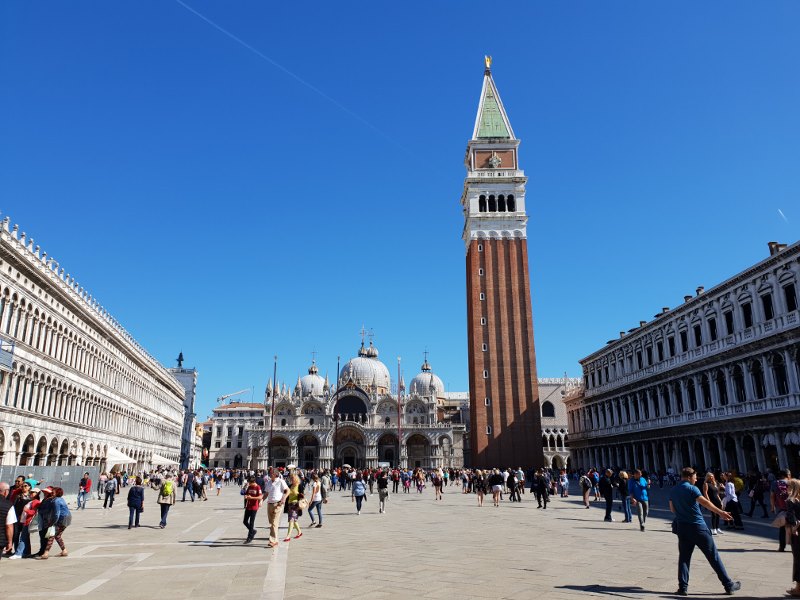Every time I go on holiday, I think; I really ought to write about this. But I never do. Mainly because I worry about whether this sort of thing comes across as some form of gloating. Or boasting. But then I asked a couple of people and they said I should go for it, so I am… At the beginning of October, Julie and I went on a short break in Venice, and these are my thoughts.
For a number of years now, Julie has been wanting to go to Venice. In fact, it’s the one place that she’s actually, consistently expressed an interest in. I’m not sure why Venice, in particular. I Mean, I know it has a reputation as a beautiful, romantic city, but most tourist cities sell themselves as that. I think it’s the idea of all the canals and the gondolas that did it; the idea of being poled through the quiet canals of the city, eating ice creams (Cornettos, maybe?). Just her, me and romance.
I, on the other hand, have never really had a hankering to go there. I’ve been to Italy. I stayed in Milan, with my brother, and Rome, with Julie. I’ve also been to Amsterdam, again with my brother(s), which has far more canals than Venice. Additionally, a few years ago, I set myself the goal of visiting a new country each year. This goal stemmed from something Julie said about setting targets for myself, to keep me moving forward. So I did. And I have. But that makes going back to a country problematic: there are so many of them out there.
But, this year was different. We visited the Dominican Republic during the Summer, thus ticking the box for a new country. So, when it came to Julie and I going away for a couple of days, a short break in Venice was the logical choice. Nay, the only choice.

To be fair, we’d have gone there before now if my health hadn’t conspired against us. It’s the sort of thing that I’d have loved to have arranged, and then just surprised her with. As it turned out, that’s, more or less, what Julie did to me. She decided on the dates. Booked the time off work. Booked the flights, and then we decided, between us, where the accommodation should be.
And the accommodation, it seems, is the biggest consideration. The flights were easy, even from Bristol; there were flights in both directions, most days. Venice even has its own airport, the Venice Marco Polo Airport, so you know that the transfer at the Italy end isn’t going to be too problematic. It’s actually less than 10 miles from the airport to the car parks and bus station on, what I’m going to, hugely inaccurately, call; Venice Island. I’ll explain why shortly.
The decision, when it comes down to the accommodation, is whether to stay on the mainland or stay on Venice Island itself. The deciding factors are:
- Staying on Venice Island is at least twice as expensive as staying on the mainland, and;
- If you stay on the mainland, you have to get transport to and from Venice Island each morning and evening.
For reasons that will very quickly become clear, we chose to save literally hundreds of pounds, for our three night short break to Venice, and stay on the mainland.
Before I go into that, though, I should explain a bit more about Venice, and why I shouldn’t be using the phrase ‘Venice Island’. Venice, you see, is made up of six boroughs, of which only two consist of the 100 or more islands that Venice is famous for. One of these island boroughs is Venezia-Murano-Burano. It is this that includes the historic city, what we picture when we think of Venice: the City of Bridges. And it is this that I’m calling ‘Venice Island’.
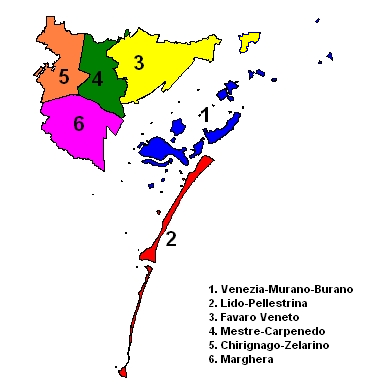
Frankly, despite the fact it’s got a huge ‘S’ shaped canal running through it, ‘Venice Island’ looks like one island. Logically, and based on Murano and Burano being separate islands (or groups of islands), you’d think that would leave ‘Venezia’ to be what I’ve been calling ‘Venice Island’. But, no; ‘Venezia’ is just the Italian for ‘Venice’. Which means that calling ‘Venice Island’, ‘Venezia’ gets us exactly nowhere. And, for that reason, I’m going to continue using the phrase, ‘Venice Island’!
The most populous borough of mainland Venice, is Mestre-Carpenedo, or just Mestre. From this borough stretches the Ponte della Libertà, the Liberty Bridge. This road and rail bridge is the only thing that physically connects Venice Island to the mainland. Except for the sea… and the sea bed… and the air… but, you know what I mean.
We stayed in a hotel on the mainland bit of Venice. It may, or may not, have been in the Mestre borough… At this stage I’ve given up caring; the geography of the city is making me want to cry!
Of course, before we could stay in our hotel, we had to get there. Venice, it seems, does not partake of Uber. Which was a shame, because we discovered Uber in the Dom Rep and found it very useful. We didn’t feel brave enough to try to decipher the buses and, knowing the hotel was about five miles away, we took a cab. I had Euros with me and figured that five miles couldn’t be more than €10, including tip. I watching, in astonishment, as the meter climbed to €13.60. Ah, well, I thought, I suppose I can give him €15. It’s a bit more than I wanted but it’s not too bad. Then he pressed a button and the meter jumped to €22.10. More than £19 (nearly $25) for an eight minute, 5 mile ride!
I ended up giving him €25 (£22, $28) just to get rid of him before the anger bubbling up, from this extortion, boiled over and ruined our short break in Venice before it had even begun. I know that some people think that Uber shouldn’t be allowed, because it puts Taxi drivers out of work. But then I remember experiences like this and think, “Aw, isn’t that a shame?!”

Anyway, at least we were at our hotel. It was the hotel Antica Fenice, which is situated on the SS14, Via Orlando; the road that connects the airport to Venice Island. The Antica Fenice hotel was about five miles, or 15 minutes, from the bus station on Venice Island, and sat on two of the bus routes. This was a major deciding factor when it came to choosing this hotel. The fact is that many of the mainland hotels advertise which bus route they are on. Or how close they are to a specific bus route. And this is very important, because the buses run very frequently and long into the night. They’re both cheap and reliable and a viable alternative to staying on Venice Island.
Another factor, which is worth considering if you do chose to stay on Venice Island, is that there are no cars there. And, literally 100s of bridges. Which sounds idyllic, and, to some extent is, but not if you’ve got a lot of luggage and your hotel is a couple of miles from the bus station…
There are plenty of water taxis (speed boats) that can take you. Likewise water buses (bigger boats), providing you’ve worked out the routes you need. There are even gondolas that can take you but you should be aware that there are fixed rates for gondola rides. The rate, at the time of writing is: €80 for 40 minutes, with an additional €40 charge for any, and all, 20 minute increments thereafter. So, gondolas are €120 (£88, $113) per hour, for up to six people. During the day. The rate increases at night. And if there’s singing involved.
But we stayed on the mainland and liked our hotel very much. The receptionist who met us in the evening had excellent English and was extremely helpful. After which, he gave us a map and marked up the areas he thought we should visit. He told us which buses we should be looking for (numbers 5 and 19), and where the nearest bus stop was (one either side of the hotel, a couple of hundred meters away). He explained the most cost effective way to use the public transport, and sold us the initial bus tickets we’d need, the following morning, to get on to Venice Island.
These tickets were €2 each, and offered a one way trip to the bus station on Venice Island. As advised, we then each bought a 48 hour travel pass, which gave us unlimited access to all buses and water buses within the Venezia-Murano-Burano and Mestre (and Torcello and Lido) area. This, however, did not include the airport, which was just outside the travel card zone. Because, of course it was. An important observation, at this point, is that all of these tickets look the same. A two day travel pass is visually indistinguishable from a €2 one-way ticket. Make sure you don’t get them confused and throw the wrong one away.
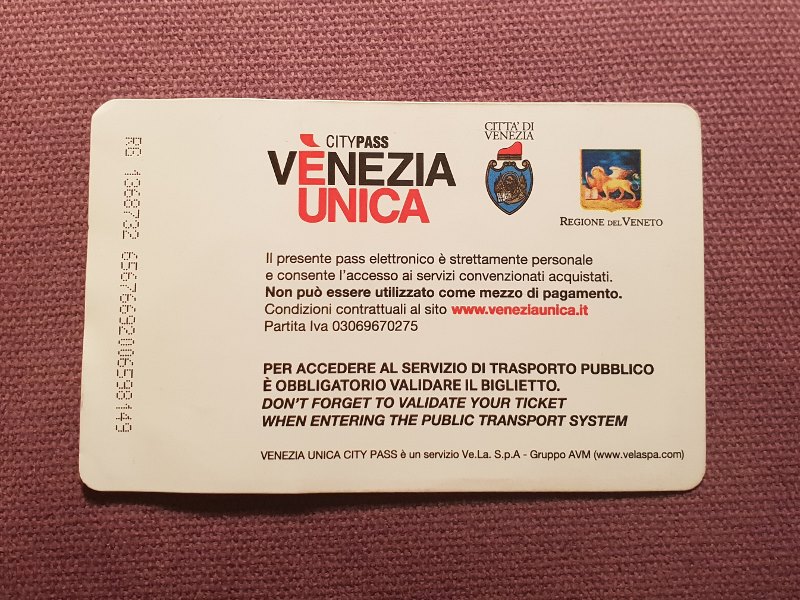
But, before then, we were at our hotel, on a Wednesday evening, and we were hungry. Confident in our ability to explore our way to a good place to eat, we spurned the Lidl supermarket that was just over the road, and set off down the Via Orlando in the direction of Venice Island. Google Maps, on the phones, suggested there were places to get food nearby, so what could possibly go wrong?
A reasonable amount, as it turned out. Firstly, the Via Orlando was a heavily used main road. It was also not particularly well suited for pedestrians. Indeed, after we’d hiked past the first roundabout, which turned our busy road into a dual carriageway, the pavement actually disappeared on a couple of occasions. At the second roundabout, we realised that there was no safe way to cross those roads to get at the restaurants clustered around the Forte Marghera. We did find a snack bar at the car park for the Parco San Giuliano but we couldn’t tell if it was open, and it didn’t look like it served anything particularly substantial anyway. There was nothing for it, other than about turn and head back the way we’d come.
It was getting towards 8:30 pm, by this stage, and the Lidl shut at 9. Not that we were allowed to go to there; we were on a short break in Venice, and Julie would be damned if we were having sandwiches from Lidl on our first night. Fortunately, about halfway out, we’d passed a Hilton Hotel. So we made our way there and they were more than happy for us to dine at their restaurant.
The food at the Hilton was perfectly fine and considerably cheaper than we’d expected. And, it was a lesson learned: when one of the biggest tourist destinations in the World is on a island, just the other side of a bridge; don’t expect to find an abundance of random restaurants on the mainland side. Especially outside the height of tourist season. Do, however, rely on bigger hotels to have a restaurant, for just this reason, and eat there.
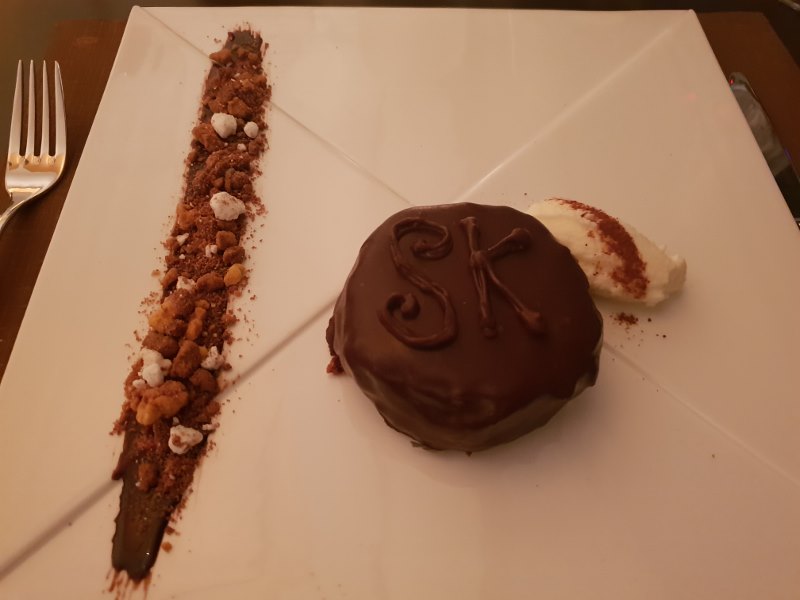
Fed and watered, we went back to the hotel and got ready for the following day. The weather was due to be cloudy but reasonably warm. In fact, we got very lucky there, despite the constant threat, we didn’t get rained on once, during our short break in Venice. As such, I was able to wear shorts and Julie could dress down to heavy jeans and a cardigan… I also had to carry a backpack with all the other layers that she might need; you know, in case of sudden-onset nuclear winter, or some such!
Breakfast was served from 8 to 10 am. So we decided to get up at about 9, catch the tail end of breakfast and then set off to explore. The receptionist in charge of mornings, also dealt with breakfast. She too had amazing English and served a pretty fine continental breakfast. Suitable fortified, we wandered up to catch the bus.
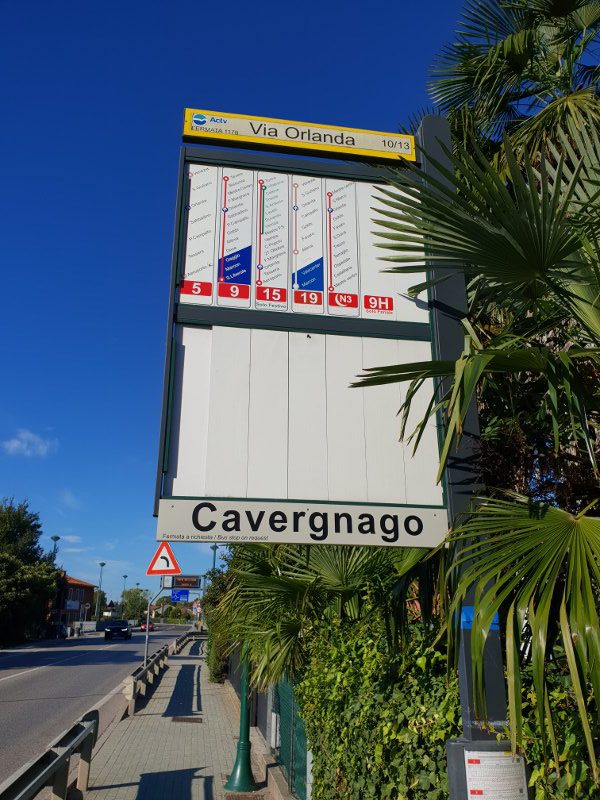
The bus stops, at least on this road, were fairly subtle affairs. Mainly identified by their signs displaying the routes that stopped there. Fine, once you know what you’re looking for. Then it was just a case of keeping an eye out for buses and sticking your arm out when you saw a number you liked the look of. In our case, that turned out to be a number 5 bus. Once on board, you have to wave your ticket in front of the pad, to activate it. Not that everyone seemed to do so. Nor did the driver seem to care. We made sure we activated the ticket on every trip, just to be on the safe side.
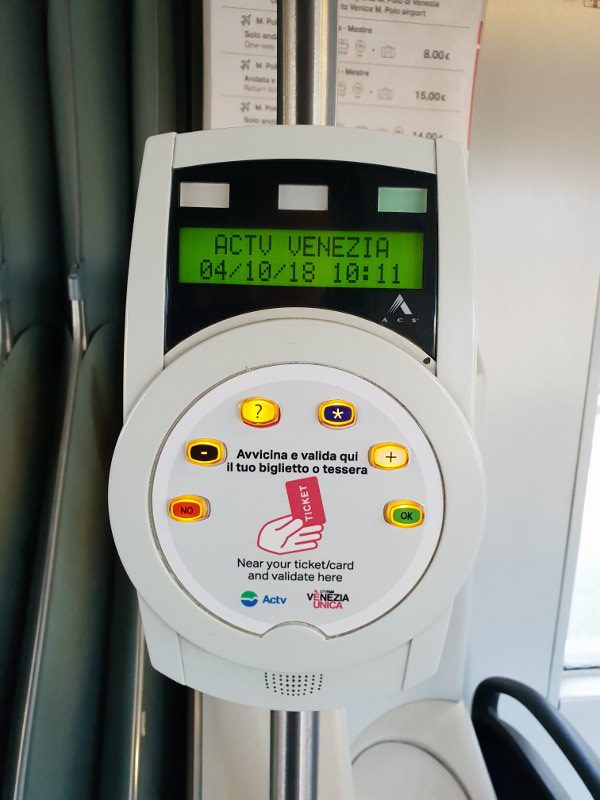
The trip across the bridge to Venice Island was pretty quick and easy, with the longest part of the journey being the traffic jam to get into the bus station. Once there, we made careful note of where the bus dropped us off, because that is also where we’d be picked up. It was right at the edge, so I didn’t need a photo of the location as a memory prompt. Like I’ve been known to do when parking my car in big, long-stay car parks… Getting old sucks!
The first thing we did was find the ticket office to buy our travel passes. The 48-hour passes cost €30 each and easily paid for themselves in relation to the number of trips we made, during our short break in Venice, had we paid for them individually.
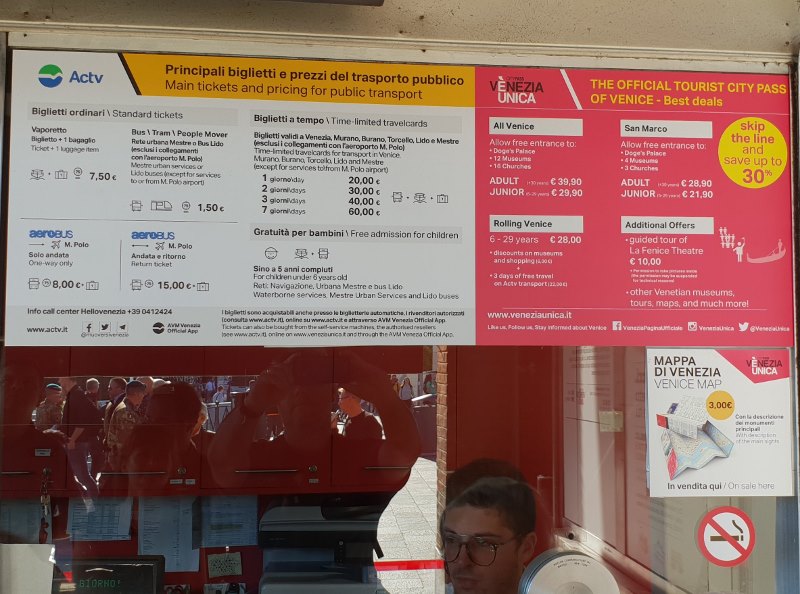
The next thing we did was find a corner to hide in, and break out the map. Not the map that the hotel had provided, although that was not a bad map. Not even the map that came with the Lonely Planet guide to Venice, which was slightly better. Nope, the map that I relied on was the Marco Polo city map that my dad had lent me. It was a scale of 1:5500 and almost a meter wide, making it completely unruly in even the faintest puff of wind. But it was detailed, accurate and waterproof. I do love a good map! ![]()
We’d already decided roughly where we were going to explore, over the course of the two days, having taken the suggestions of the receptionist from the first night on board. The plan involved getting to all six of the sestieri of Venice Island, as well as Murano. Sestieri basically means ‘sixths’. Venice is split into six parts, sometimes called communes, of which ‘Venice Island’ is one. Venice island is split into six parts, also sometimes called communes, presumably in an attempt to drive me mad. Well, it’s working!
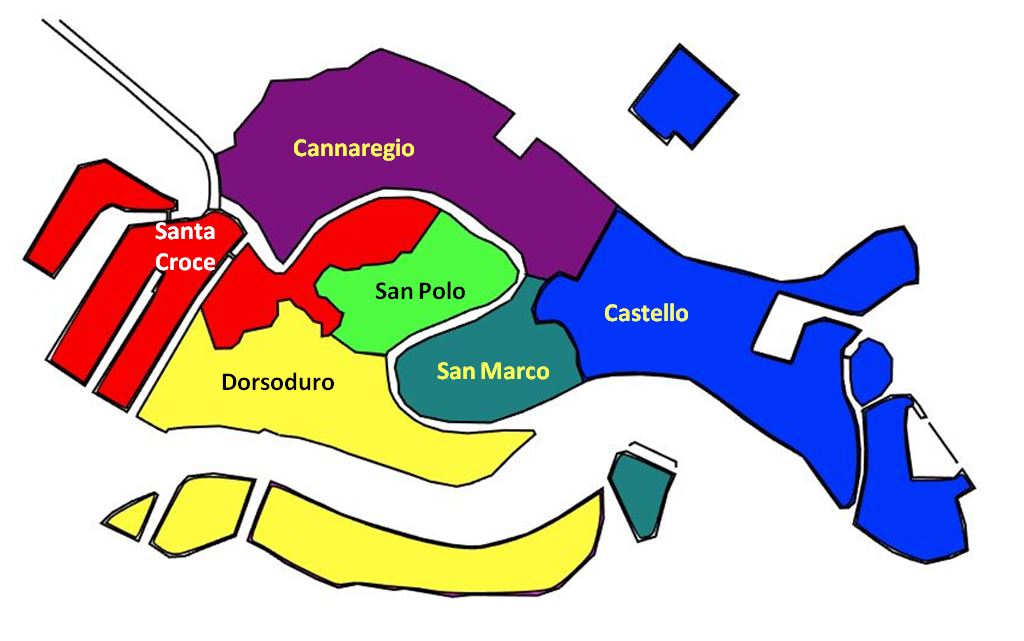
We’d navigate each day by going between the more impressive looking churches and squares on the map, roughly in the direction of the main destination. You have to do some variation of this tactic, because there are no straight routes on Venice Island. There are lots of canals, which have a limited number of bridges. You plan your route between the churches and the squares based on the location of the bridges. Good luck trying anything else… These bridges, incidentally, crop up in the most unexpected of places. Main roads can just stop without a bridge. Tiny alleys can lead to huge bridges. I wouldn’t be at all surprised if they moved overnight, like in Hogwarts.
The Day 1 Itinerary was:
- Bus Station
- San Polo Sestieri
- San Marco Sestieri (via Ponte di Rialto – the Rialto Bridge)
- Castello Sestieri
- Dorsoduro Sestieri (via water bus)
- Bus Station (via water bus up the Grand Canal)
The Day 2 Itinerary was:
- Bus Station
- Cannaregio Sestieri
- Murano (via water bus)
- Back to Cannaregio Sestieri (via water bus)
- Santa Croce Sestieri
- Bus station
Okay, it turns out that this travel writing lark requires a bit more detail than I was expecting. And I haven’t got on to any of the sights yet! Which means that I’ll have to save the actual sightseeing aspects of my short break in Venice, for my next post; Sightseeing in Venice with Julie. Imaginative title, huh?!
